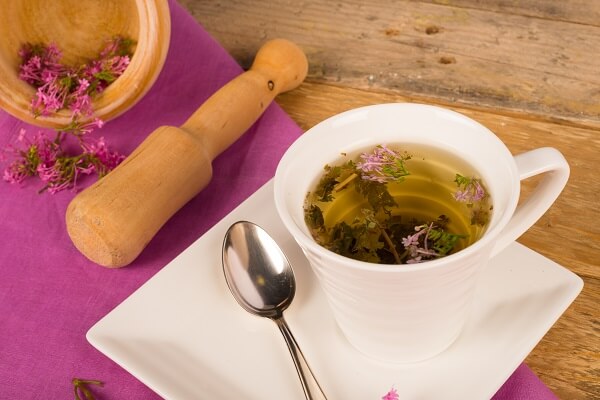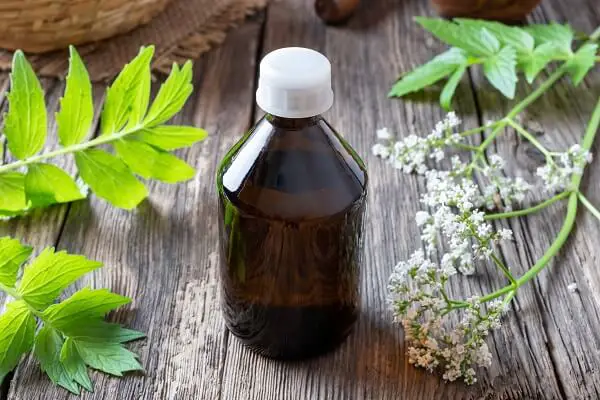Estimated reading time: 9 minutes
Disclaimer: I am not a medical doctor and nothing in this article should be taken as medical advice. Please talk to your doctor before using any of the herbs and/or remedies mentioned in this article.
Valerian root should be a staple in every homesteading apothecary. It boasts a plethora of natural healing properties and it's very easy to grow and preserve.
The root, which grows natively in Europe, has been used as part of herbal remedies designed to treat insomnia for centuries. In fact, it was Hippocrates who first notably used valerian root to treat anxiety, headaches, trembling, and even heart palpitations.
This hardy root is typically brewed into a tea to ingest it and garner its natural healing powers. Valerian root is also turned into tinctures, essential oil, and homemade gel capsules. The medicinal root is sometimes used as a flavoring in soft drinks and dessert dishes.
Valerian is a member of the Valerianaceae family and known also by its scientific classification – Valeriana officinalis. The root is native to both Asia and Europe, but has been naturalized to the North American continent.
It is a perennial plant that produces white, pink, or purple flowers that bloom in the middle of the summer.
The healing root boasts a distinct and rather unpleasant odor. There are more than 250 different species of valerian root. The Valeriana officinalis is the species most often used medicinally and the type that now grows throughout the United States.
Want to save this post for later? Click Here to Pin It on Pinterest!
Valerian Root Medicinal Uses
Valerenic acid, the active compound in valerian root, is thought to impact the brain’s gamma-aminobutyric acid – or GABA, receptors. One of the primary functions of the GABA is to control nerve cells when they become overly stimulated by anxiety or fear. Ingestion of the root can act as a mild and natural anxiety-reducing drug or sedative.

Here are some of the main things it can treat:
Anxiety
Some folks who do not want to use chemical-laden prescription drugs like Atian, Xanax, or Valium to treat anxiety use valerian root as a natural alternative. The root may have the same or similar sedative style impact as drugs like Xanax, but does not come with all the side effects or synthetic ingredients. Valerian may also help to naturally alleviate other mood disorders.
A Harvard Medical School study conducted in 2015 found that of the 12 traditional healing herbs used to treat anxiety, valerian root was the “most promising” option for combating bipolar disorder associated with anxiety. Some of the other herbs reviewed in the Harvard study include ginko, hops, and gotu kola.
Insomnia
This is one of the most popular uses for valerian root. In fact, it is often referred to as “nature's valium.” As I mentioned above, the root also acts as a mild sedative. So as long as you don't have any caffeine or other stimulants in your system, it should help you to fall asleep.
Menopause Symptoms
It is possible that valerian root could minimize incidents of hot flashes that commonly accompany menopause. Exactly why the medicinal root helps curtail hot flashes remains unknown. There is currently no evidence that valerian root influences the hormone levels in menopausal women, yet it can help alleviate this dreaded change of life symptom.
In 2013, a valerian study shared by the NCBI indicated that 68 women who took 225 milligrams of the healing root three times a day for eight weeks reported a significant decrease in not only the frequency of hot flashes, but the severity of the incidents, as wee.
Other Health Benefits
This healing root also has been used to treat digestive issues, fatigue, headaches, exercise-induced muscle pain, etc. It should be noted that these particular benefits have limited evidence, but you can find lots of testimonials.
Using Valerian Root
The underground stems or rhizomes as well as the stolons – horizontal stems – of valerian root are typically used in medicinal home remedies and commercially available supplements.
Dried roots from valerian are prepared in tinctures, teas, tablets, or gel capsules for holistic health use. If you are going to grow valerian root for medicinal purposes, investing about $50 in a manual gel capsule machine and supplies is highly recommended.
Valerian Root Dosage
Adults typically take about 300 to 600 milligrams of valerian root approximately half an hour to two hours before going to sleep to help fight insomnia.
A valerian root study by the National Institutes of Health revealed that participants consuming the healing root experienced substantially improved sleeping habits. The medical volunteers reported better quality of sleep, taking less time to fall asleep, and waking up fewer times during the middle of the night.
If taking the healing root as a tea, steep approximately two or three grams of the dried root in a standard coffee cup filled with water for around 15 minutes before drinking.
When taking valerian root for anxiety, the common recommended dosage is 120 to 200 milligrams up to three times per day. Typically, the dosage for the root to treat anxiety is lower than the dosage advised for adults to take when combating insomnia.
Valerian Root Safety
The root, like most natural supplements, are not thoroughly regulated by the United States Food and Drug Administration – FDA. But, the government agency has dubbed valerian root “GRAS” or generally recognized as safe and prompting only mild side effects.
Possible Valerian Side Effects:
- Dizziness
- Stomach Ache
- Headache
- Drowsiness
Valerian Root Warnings:
- It is not recommended for pregnant and nursing women or children under the age of three. Studies to determine if ingesting the root by these women and young children have not been conducted.
- Because of the potential to develop drowsiness after taking valerian root, it is not recommended to operate heavy equipment or drive a vehicle.
- It is not recommended that the healing root be taken in conjunction with other sleep aids – natural or otherwise, antidepressants, sedatives, or alcohol.
- There is a possibility that due to the natural sedative effect of valerian root, consumption could become a habit or addictive.
- Taking valerian could enhance the effects of anesthesia. If surgery is in your near future, discuss the consumption of valerian root with your doctor.
Valerian Root Tea Recipe
- Steep 1 teaspoon of dried valerian root in 1 cup of water for 10 to 15 minutes. Roots take longer to thoroughly steep, so use the full 15 minutes when using this part of the plant in a medicinal tea. Note, the longer the dried root steeps, the more potent its tell-tale odor becomes.
- Strain the mixture.
- Drink when it is cool enough to not burn the mouth.

Valerian Root Tea Flavorings:
- To make valerian root tea both smell and taste better, add a pinch or two of honey to the mixture. Honey boasts not just a sweet taste but healing properties of its own. To garner the biggest medicinal boost from this optional ingredient, use raw honey.
- Add a capful of lemon juice or a little bit of fresh juice from the fruit to the tea.
- Peppermint, just a pinch or two, is also a common valerian tea additive. Like honey, peppermint also boasts healing properties.
- Mixing a teaspoon of milk to the tea can also counteract the slightly bitter taste of valerian root tea.
- A spoonful of sugar will once again help the medicine go down, as well.
You can add one or a combination of these recommended additives to the valerian root tea to improve taste without reducing its potent effect.
Valerian Root Tincture Recipe
Homemade tinctures are commonly used when preparing either roots or berries for a healing natural remedy. Typically, tinctures of this type pull the healing compounds out of the natural healing base ingredients far more effectively when extracted using either alcohol or a vegetable glycerin than water. The vast majority of studies conducted on valerian root use alcohol and not water-based extracted tinctures.
The glutamine, a powerful medicinal compound in valerian root, is perhaps the only part of the plant that may perform better when extracted to make a tincture with water instead of alcohol. Glutamine is one of the building blocks that create GABA. A valerian root tincture may increase GABA signaling within the body.

Ingredients:
- 1 cup of vodka – 80 proof is often used, but if possible, use 100 proof.
- ½ a cup of dried valerian root.
Directions:
- Fill a 1 quart Mason jar (or similar glass jar) approximately halfway full with the dried valerian root.
- Pour in the vodka.
- Put the lid and ring on the Mason jar and make sure that it is screwed on firmly.
- Shake the jar vigorously for about 60 seconds.
- Using a permanent marker or a piece of Scotch tape that can be written upon, label the jar with both its contents and the date.
- Place the jar in a dark place that is not cool, but at least relatively warm. The valerian root mixture must steep in the sealed Mason jar for five weeks to fully process.
- Shake the mixture on a regular basis. I shake mine once or twice a day.
- At the end of the five weeks, give the Mason jar another vigorous shaking.
- Strain the valerian root tincture through cheesecloth or several coffee filters to capture the liquid. Pitch the strained away natural matter.
- Pour the valerian root tincture in a clean Mason jar and seal it with another lid and a firmly fitting ring.
- Store the natural healing tincture in a cool dark place until ready to use.
It may take up to two weeks of regular consumption of valerian root to see successful results. Whether or not you should take the root for longer than 30 days straight or long term, is a discussion to be had with your doctor. I am not a medical professional and am sharing information about valerian root for purely educational and research purposes.
Like this post? Don't Forget to Pin It on Pinterest!













Thanks. I hope you might do an article about buying herbs in bulk, how to store & label, how to portion servings, and some examples of how much $ that saves versus buying capsules in bottles and tea bags in boxes. I can’t believe all the years I spent and how many dollars not saved because it took me too long to figure that out.
Spotted one possible typo: “but if possible, use 10 proof.” (should be 100?)
Glad you like the article. Thanks for pointing out the typo!